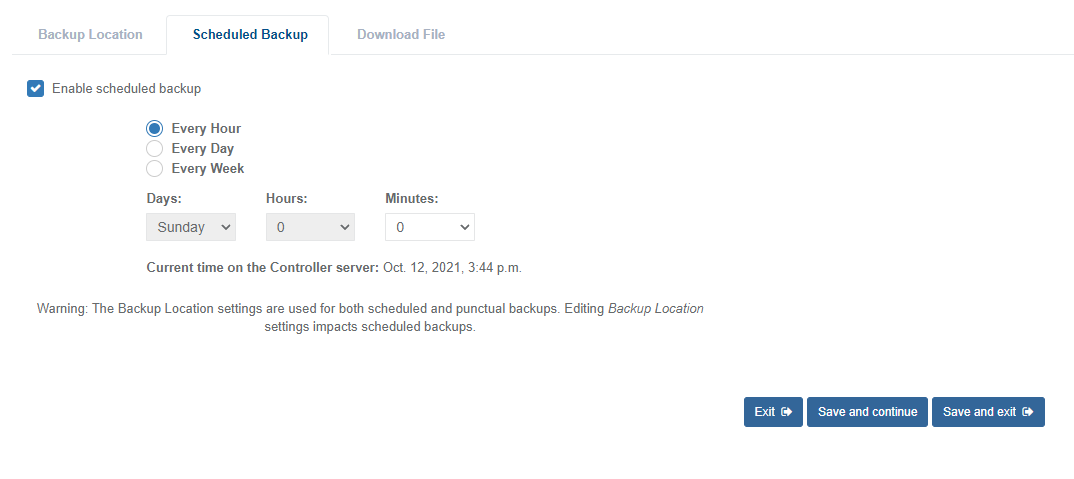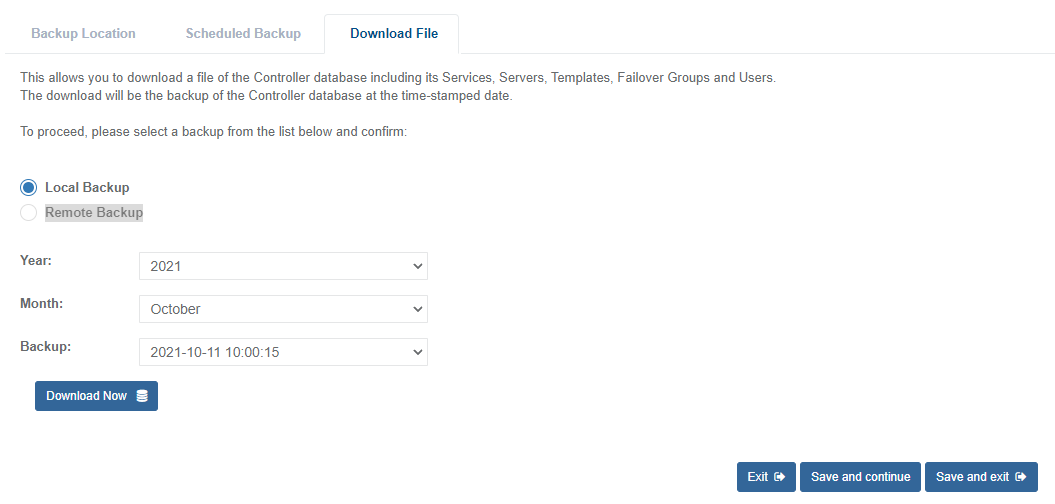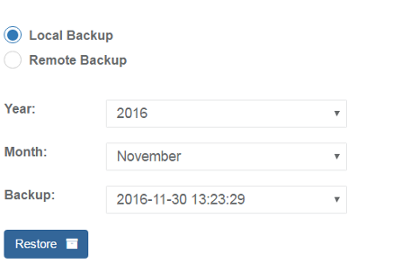Backup and restore
Backups include services, templates,failover groups,server definitions and locally defined users. You can back up your configurations to restore a previous configuration (for upgrades or rollbacks or after a server crash, etc.)
The access to configurations is blocked while a backup or restore is in progress. Up to 30 backup files are supported for local backups. The oldest backup is deleted once 30 backups are detected.
Backup database configurations
Create a backup of MediaKind configurations to save a version locally or on a remote server.
Display backup MediaKind database options
Back up the MediaKind configuration to a local or remote server. Backups include services, servers, templates and users. Backups are time-stamped.
- Click in the upper-right corner of the screen. The System Center menu displays.
- Select Backup. The Backup Controller Database options display.
Create a local backup
Local backups of MediaKind settings are still accessible even when no remote access is possible. Backups only include the list of servers, services, templates and user configurations.
-
Display backup options. Local Backup is selected by default.

The Host, Port and Path are only required for a remote backup. FTPS is also authorized.
- Click Backup now. The backup is stored on the local drive.
Create a remote backup
Create remote backups to restore MediaKind settings from a remote server using FTP or FTPS.
- Display backup options.
- Select Remote backup. Required fields are highlighted.
- Enter the required remote backup settings information.
FTPS is also authorized.

Editing the backup file storage location impacts scheduled backups.
- Click Backup Now.
- Click Save and exit to save your changes.
Schedule an automatic backup (periodic)
Set a schedule to back up the MediaKind database on a regular basis: weekly, daily or hourly. Backup guard times may impact backup availability.
- Display backup options.
- Select the Scheduled Backup tab to define the scheduled backup.
- Select the Enable scheduled backup checkbox.
- Select the backup schedule time (hourly, weekly, daily and so on).
The time stamp is based on the current time on the Controller server.

- Open the Backup Location tab to set the backup file storage settings, if they are not currently configured.
- Click Save and exit to save your changes.
Download the Controller database file
This tab enables users to download the Controller database file. This file includes Services, Servers, Templates, Failover Groups and Users and indicates the backup of the Controller database at the time stamped date.
- Display backup options.
- Select the Download File tab to download the Controller database file.
- Select Local Backup to download the locally backed up database.
Downloading remote backups is not currently available.
-
Use the Year/Month/Backup drop down lists to select the backup instances to download, as follows:
- From the Year drop down list, select the year when the required backup was created.
- From the Month drop down list, select the month when the required backup was created.
- From the Backup drop down list, select the required backup which includes the time stamp with the time and date.

-
Click Download Now to begin downloading the file locally.
-
Click Save and exit to save your changes.
Restore configurations
Restore configurations for recovery or troubleshooting. You must have already created a local or remote backup in order to restore. Backups are selected based on the backup time stamp.
The Database is inaccessible until the restore completes. Only one restore can be launched at a time. Alarms and statistical data are not restored because they are dynamic. The alarms banner is not displayed until the restore completes.
Display restore options
You can restore the MediaKind database configuration from existing local or remote backups.
- Click in the upper-right corner of the screen. The System Center menu displays.
- Select Restore. The Restore Controller Database page displays.
Restore configurations from a remote backup
- Display restore options.
- Select Remote Backup.
- Select a Year > Month > Backup.
Available backups are time-stamped. Be aware of backup guard time configurations to ensure availability.

- Click Restore. The Controller is unavailable to all users until the restore completes.
Restore configurations from a local backup
-
Display restore options. Local Backup is selected by default.

-
Expand the Backup drop-down list to display available backups, then select a backup to restore.
Available backups are time-stamped. Be aware of backup guard time configurations to ensure availability.
- Click Restore. All users are temporarily assigned to the Monitoring user group until the restore completes or is terminated.